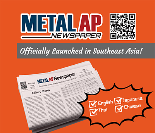
China Foundry
Scope & Guideline
Shaping the Future of Materials Science and Engineering
Introduction
Aims and Scopes
- Metal Casting Techniques:
Research on various metal casting methods including traditional and advanced techniques such as high-pressure die casting, sand casting, and additive manufacturing. - Material Characterization and Properties:
Investigations into the microstructural characteristics, mechanical properties, and performance of different alloys and composites utilized in casting processes. - Process Optimization and Simulation:
Development and application of numerical simulation techniques to optimize casting processes, including thermal analysis, fluid flow modeling, and solidification behavior. - Innovative Materials Development:
Exploration of novel materials, including high-entropy alloys, composite materials, and advanced coatings aimed at improving the performance and durability of cast products. - Environmental and Economic Sustainability:
Research focused on reducing the environmental impact of foundry operations through waste recycling, energy-efficient processes, and sustainable material usage. - Casting Defects and Quality Control:
Studies aimed at understanding and mitigating casting defects, enhancing quality control measures, and implementing advanced testing techniques.
Trending and Emerging
- Additive Manufacturing in Foundry:
Significant growth in publications related to additive manufacturing techniques, emphasizing their application in producing complex geometries and enhancing design flexibility in casting. - Advanced Characterization Techniques:
An increasing focus on advanced characterization methods such as machine learning, artificial intelligence, and high-throughput experimentation to understand material properties and optimize processes. - Sustainability and Green Foundry Practices:
A rising trend towards research on sustainable practices, including the recycling of materials, energy-efficient processes, and the use of eco-friendly materials in foundry operations. - High-Entropy Alloys and Novel Materials:
Emerging interest in high-entropy alloys and other novel materials that offer superior mechanical properties and performance for demanding applications. - Simulation and Digital Twins:
Growing emphasis on the use of simulation tools and digital twin technology to improve process design, predictive maintenance, and operational efficiency in foundry operations.
Declining or Waning
- Traditional Foundry Techniques:
There is a noticeable decline in publications centered on classical foundry techniques, as research increasingly shifts toward innovative methods and technologies. - Basic Alloy Development:
Research focusing on basic alloy compositions and their properties appears to be waning, with a shift towards more complex, high-performance alloys and composites. - Non-Automated Quality Control Methods:
The use of manual or non-automated quality control methods in foundry processes has decreased, as more emphasis is placed on automation and digitalization for enhanced efficiency.
Similar Journals
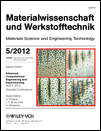
MATERIALWISSENSCHAFT UND WERKSTOFFTECHNIK
Innovating Tomorrow's Materials Today.MATERIALWISSENSCHAFT UND WERKSTOFFTECHNIK, published by WILEY-V C H VERLAG GMBH, is a prominent journal dedicated to the field of materials science and engineering. With its ISSN 0933-5137 and E-ISSN 1521-4052, this journal serves as a vital resource for researchers and professionals engaged in exploring the intricate relationships between the properties of materials and their applications. Established in 1970 and continuing through 2024, the journal has been consistently recognized in various categories, achieving a Q3 ranking in 2023 across Condensed Matter Physics, Materials Science (miscellaneous), Mechanical Engineering, and Mechanics of Materials. Although it does not offer open access, its high-quality peer-reviewed content is fundamental to the advancement of knowledge within its three key areas: novel material development, material characterization, and application of materials in engineering contexts. As a driving force in the scientific community, MATERIALWISSENSCHAFT UND WERKSTOFFTECHNIK continues to cater to the curiosity of aspiring students, seasoned professionals, and researchers alike, facilitating a deeper understanding of the complexities of material technology.

TRANSACTIONS OF THE INDIAN INSTITUTE OF METALS
Fostering excellence in metallurgy and materials research.TRANSACTIONS OF THE INDIAN INSTITUTE OF METALS is a premier journal published by Springer India, dedicated to the field of metallurgy and materials science. Established in 1969, this journal serves as a vital platform for researchers and professionals to disseminate their findings on metals and alloys, showcasing innovative studies and experimental techniques. With an impressive impact factor and categorized in the Q2 quartile for metals and alloys as of 2023, it ranks 70 out of 176 in its field according to Scopus, placing it in the 60th percentile. The journal maintains a robust reputation for fostering academic excellence, thus attracting contributions from both established and emerging scholars. Though not an open access publication, its well-curated content remains a crucial resource for advancing knowledge and technology in metallurgy. The journal's extensive operational history, particularly during notable converged years, underscores its enduring significance in the scientific community.
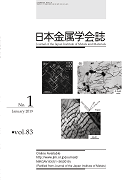
Journal of the Japan Institute of Metals and Materials
Illuminating the future of materials science and engineering.Journal of the Japan Institute of Metals and Materials (ISSN: 0021-4876, E-ISSN: 1880-6880) serves as a vital academic platform under the esteemed auspices of the Japan Institute of Metals & Materials. This journal, with a rich publication history dating back to 1937, focuses on advancing knowledge in the fields of metallurgy, materials science, and engineering, making it an important resource for researchers, professionals, and students alike. Although the journal has been categorized in Q4 quartiles across several subject areas, including Condensed Matter Physics and Materials Chemistry, it plays a critical role in disseminating essential findings and fostering discussion regarding innovations in metal and materials research. Notably, the journal operates without open access, which encourages targeted readership engagement through its curated content. Based in Japan, it continues to contribute significantly to the academic community by bridging the gap between scientific inquiry and practical application in materials technology.
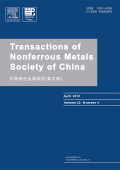
TRANSACTIONS OF NONFERROUS METALS SOCIETY OF CHINA
Elevating the discourse on materials chemistry and engineering geology.TRANSACTIONS OF NONFERROUS METALS SOCIETY OF CHINA, published by Elsevier, is a premier academic journal that serves as a vital platform for researchers and professionals specializing in materials science, condensed matter physics, geotechnical engineering, and engineering geology. Established in 1994, this esteemed publication has maintained a robust focus on the latest developments in the nonferrous metals sector, reflecting its significant impact in the field with a Q1 categorization across multiple disciplines. With impressive Scopus rankings—placing it in the top 20% of journals in relevant categories—this journal is recognized for its quality and rigor, providing critical insights into metals and alloys, materials chemistry, and their applications. The non-open access format ensures a dedicated readership among professionals and academics seeking substantial and authoritative research articles. By fostering knowledge exchange, the journal strives to advance the understanding and application of nonferrous metals, making it an essential resource for anyone involved in material innovations and engineering solutions.
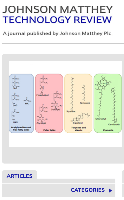
Johnson Matthey Technology Review
Fostering innovation and knowledge exchange in chemical engineering.Johnson Matthey Technology Review is a premier open access journal published by Johnson Matthey Publishing Ltd, dedicated to advancing research and innovation in the fields of Electrochemistry, Metals and Alloys, and Process Chemistry and Technology. Since its transition to open access in 2014, the journal has provided a platform for scholars and industry professionals to share their findings and insights in a rapidly evolving field. Based in the United Kingdom, this journal has garnered significant attention, achieving impressive rankings such as Q3 in Electrochemistry and Q2 in Metals and Alloys, reflecting its growing impact within the scientific community. With a commitment to promoting high-quality, peer-reviewed research, the Johnson Matthey Technology Review plays a vital role in connecting researchers, facilitating knowledge exchange, and fostering collaboration across disciplines, making it an essential resource for anyone involved in material science and chemical engineering.

ADVANCED MATERIALS & PROCESSES
Elevating Engineering Through Innovative Materials ResearchADVANCED MATERIALS & PROCESSES is a vital resource for professionals and researchers in the fields of Materials Science, Mechanical Engineering, and Mechanics of Materials, published by ASM International, a renowned leader in material science publishing. Since its inception in 1985, this journal has aimed to disseminate cutting-edge research and innovative developments in advanced materials usage and processing techniques, contributing to the advancement of engineering applications. Despite its current Q4 quartile ranking in its respective categories, the journal endeavors to elevate the discourse within the field by providing a platform for high-quality articles, reviews, and case studies. Subscribers can benefit from insights into the latest trends and technologies that shape the materials landscape, although the journal is not open access. With its broad coverage and commitment to supporting the academic and professional community, ADVANCED MATERIALS & PROCESSES remains an essential publication for anyone invested in the future of materials innovation.

Metallurgical Research & Technology
Elevating the standards of metallurgical research and engineering.Metallurgical Research & Technology is a distinguished journal published by EDP SCIENCES S A based in France, focusing on the dynamic field of metallurgical science and engineering. With a strong emphasis on the latest advancements in Materials Chemistry, Computational Mechanics, and Mechanics of Materials, this journal aims to provide a platform for researchers to share innovative findings that propel the field forward. As of 2023, it has secured a commendable position in various categories, including Q3 rankings in Computational Mechanics, Materials Chemistry, and Mechanics of Materials, along with a Q2 ranking in Metals and Alloys. The journal actively promotes open access, facilitating broader dissemination of critical research across the globe. Researchers, professionals, and students in the metallurgical domain will find Metallurgical Research & Technology an invaluable resource for cutting-edge developments and collaborative opportunities.

METALLURGICAL AND MATERIALS TRANSACTIONS B-PROCESS METALLURGY AND MATERIALS PROCESSING SCIENCE
Navigating the Complexities of Process Metallurgy and MaterialsMETALLURGICAL AND MATERIALS TRANSACTIONS B-PROCESS METALLURGY AND MATERIALS PROCESSING SCIENCE, published by Springer, serves as a pivotal platform in advancing the field of materials science, focusing specifically on the intricacies of process metallurgy and materials processing. With an ISSN of 1073-5615 and an E-ISSN of 1543-1916, this esteemed journal boasts an impressive standing with its 2023 category quartiles, ranking Q2 in Condensed Matter Physics, Materials Chemistry, and Mechanics of Materials, while achieving a top-tier Q1 classification in Metals and Alloys. Positioned in the United States, the journal has been publishing leading research since its inception, with converged years spanning from 1973 to 1979 and 1995 to 2024. The journal's robust impact within its fields is reflected in its Scopus rankings, notably ranking #42 out of 176 in Materials Science with a 76th percentile. Though not an open access journal, its comprehensive and high-quality research articles cater to the needs of researchers, professionals, and students, ensuring they remain at the forefront of advancements in metallurgy and materials processing science.

RUSSIAN METALLURGY
Advancing Metallurgical Science and InnovationRUSSIAN METALLURGY is a distinguished journal published by PLEIADES PUBLISHING INC, focusing on the fields of metals and alloys. With an ISSN of 0036-0295 and an E-ISSN of 1555-6255, this journal serves as a vital resource for researchers and practitioners alike, offering insights into the latest advancements and innovative research within the metallurgy domain. Recognized in a competitive landscape, it holds a Q3 ranking in the Metals and Alloys category as of 2023, reflecting its commitment to rigorous scientific dissemination. The journal spans a significant historical timeline of research since its inception in 1984, with aims to advance the knowledge and application of metallurgical science. Although currently not open access, it remains crucial for those aiming to stay current in the dynamic field of materials science. RUSSIAN METALLURGY fosters a deeper understanding of the physical and chemical properties of metals, guiding future innovations in industry and academia.

METALS AND MATERIALS INTERNATIONAL
Connecting researchers to the forefront of materials science.METALS AND MATERIALS INTERNATIONAL, published by the Korean Institute of Metals and Materials, is a prestigious journal dedicated to the advancement of research in the fields of materials science and engineering. With an ISSN of 1598-9623 and a robust e-ISSN of 2005-4149, this journal has established itself as a crucial platform for disseminating innovative findings and key advancements that span condensed matter physics, materials chemistry, mechanics of materials, and the technology of metals and alloys. Its Q1 rankings in multiple categories attest to its high impact and relevance in the academic community, placing it among the top journals in its fields with Scopus rankings that reflect a strong international footprint. Here, researchers, professionals, and students can access cutting-edge research and insights, fostering collaboration and exploration of new materials and their applications. With a commitment to excellence and a convergence of knowledge from 1996 to 2024, METALS AND MATERIALS INTERNATIONAL continues to enhance our understanding of materials and their transformative impact on technology and engineering.